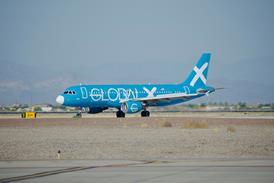ICAO is set to launch a calculator that aims to end passenger confusion about measuring their environmental impact.
The International Civil Aviation Organisation could launch as early as May a web-based carbon footprint calculator vetted by the international aviation community, a tool that will give airline passengers an unbiased and transparent first-order assessment of their CO2 emissions for a given flight between city pairs.
ICAO expects CO2 levels from aviation to reach more than 1,200 million tonnes annually by 2025, a more than doubling of today's values. Each tonne of jet fuel produces more than 3 tonnes of CO2, the main by-product of combustion.
The need for a consensus-based tool has gained momentum in the industry as CO2 calculators proliferate on the internet and as passengers are increasingly being offered monetary carbon offset options when buying tickets. The International Air Transport Association says up to 10% of airline passengers worldwide contribute money to the programmes.
INACCURATE MODELS
There is also the potential that environmentally conscious passengers will use inaccurate models to make their travel choices. Hugo Kimber, chief executive of UK-based Carbon Responsible, says that while there's no evidence that people are using calculators as a way of making flight choices, they are however using the tools to decide whether to travel by bus, rail or air.
Today's first generation calculators are typically generic in that results are dependent on distance travelled and not influenced by the operator, type and age of aircraft, delays and other factors that directly impact the actual fuel burned, hence the CO2 generated.
Even simple models are problematic. Kimber says he has seen carbon footprint variations as great as 300% for the same flight looking at 40 different calculators online.
"I'm not saying there's something wrong with the calculators," says Jane Hupe, chief of the environmental unit at ICAO, "but they're not transparent. We're not sure what's there."
The model that ICAO is proposing to use, pending approval by a technical task group under the Committee on Aviation Environmental Protection, is a "general" calculator that computes per-seat CO2 on flights between city pairs. Hupe says the aim is to consider the most direct flights, though intermediate stops can be added. The model, as proposed, uses 50 different types of aircraft that represent the most typical aircraft types that airlines use for travel between the selected city pairs.
Hupe expects the calculator output, which is based on estimated fuel burn, to be within 10% of the actual CO2 produced, a combustion by-product directly proportional to the actual amount of fuel burned.
A consensus model will be a welcome addition to the industry. Dan Dulik, director of global marketing support for OAGback, says his company has been approached by travel agencies, airports and airlines who want to be able to calculate their carbon footprint in order to be able to determine which airports, aircraft and routes offer the minimal environmental impact on the community. The company currently offers what Dulik says is a "very basic" calculator. "Everyone's looking to be a good corporate citizen," he says. "We'll build a custom calculator for someone, but first we need an industry standard."
IATA director general and chief executive Giovanni Bisignani says: "Customers, particularly corporate customers, are demanding the opportunity to offset the impact of their travel. But there are no easy solutions. There is no standard calculation for the carbon emission for each trip." With such a model in hand, IATA plans to develop a voluntary carbon offset "standard scheme" for airlines and passengers to participate in. "Our target is to have the programme running by the end of the year, with at least six airlines participating," Bisignani says.
Hupe declines to call the ICAO calculator a "standard" as that would imply mandatory use, but says it is more of a starting point for discussions, one that will evolve over time. "We're coming up with the methodology and information that is needed," she says. "If airlines have specific information (that will make the calculators more precise), they can give their passengers that information."
By giving the public the background and rationale for the calculator on ICAO's website, Hupe says the effort could plant the seeds for harmonization in the aviation community regarding the computation process in general and what should logically follow. "The first step is how to calculate," she says. "The second step is to gather information about carbon offset programmes. Doing offset programmes before the calculations are correct is not what we feel is the correct way to go forward."
|
|
|---|
© Airbus |
Source: Flight International
























